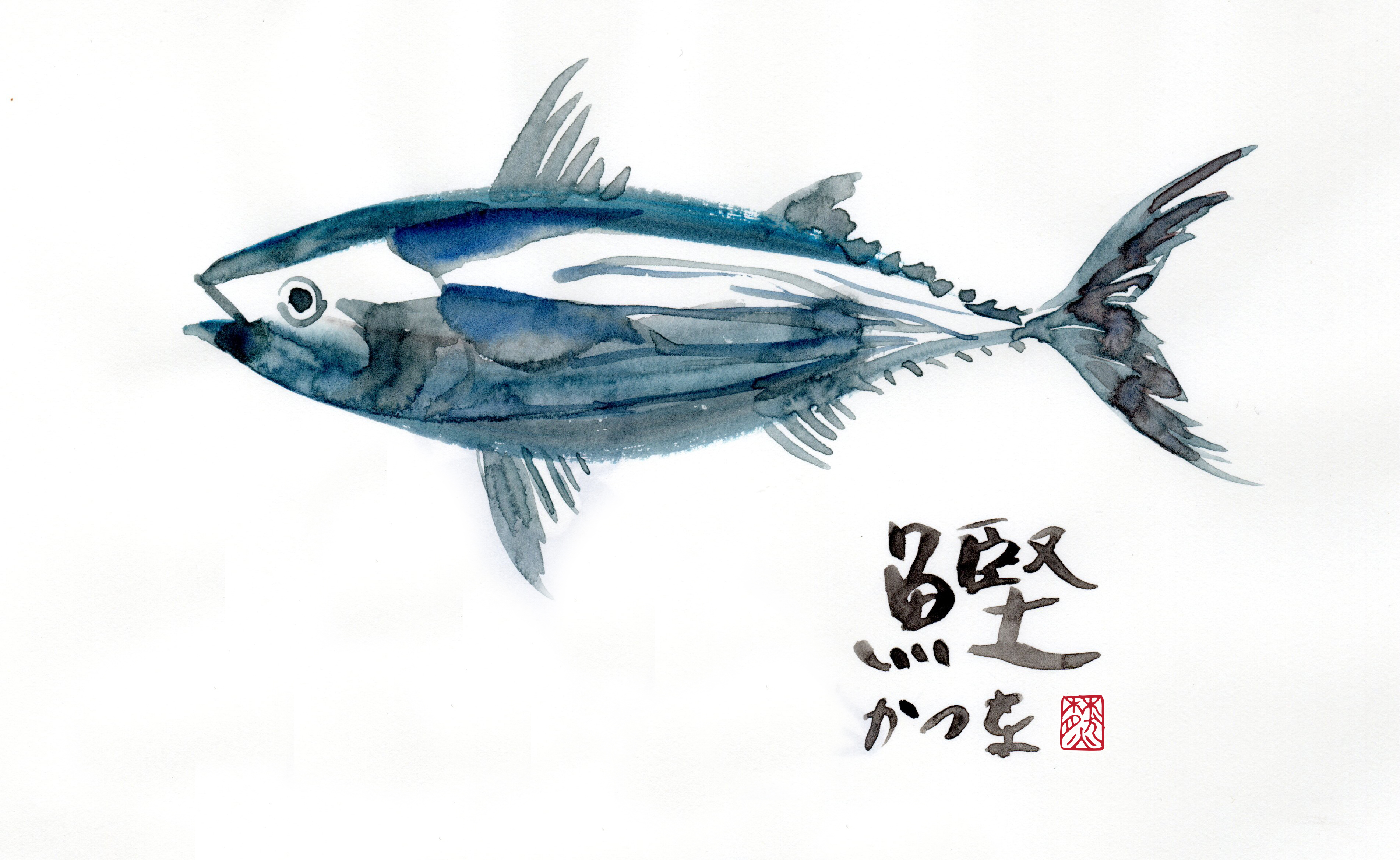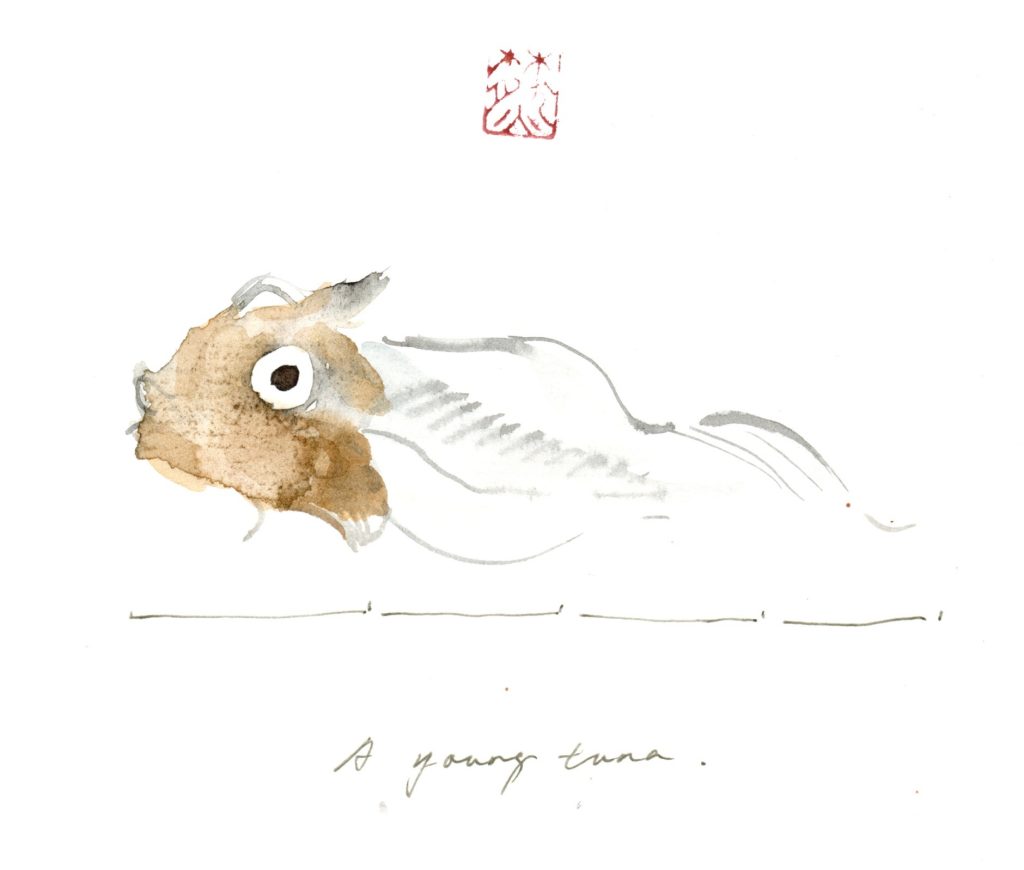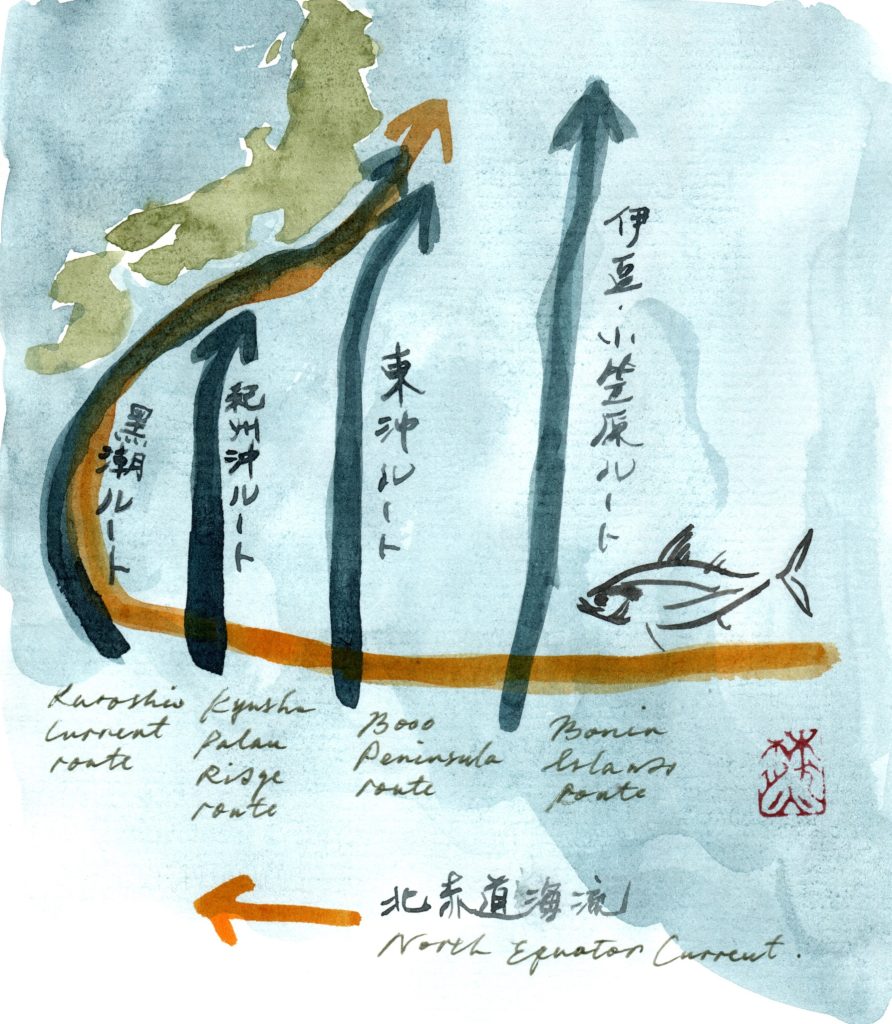All art and illustrations in this series and article have been contributed kindly by the lovely Linran, who can be found at https://linranjiang.info/
This article is part of a series that follows on from 8. How to sharpen a Kezuriki (削り器を研ぐ)
Katsuobushi (鰹節) are dried fish that are typically shaved and steeped in water to make dashi, the foundational stock to Japanese cuisine. Katsuobushi is made by drying and fermenting Skipjack Tuna (scientific name: Katsuwonus pelamis) or as it’s sometimes called- Bonito.

the following information was obtained from reports published on the websites of the following organizations:
Japan Fisheries Research and Education Agency (水産研究教育機構) https://www.fra.affrc.go.jp/index.html
Japan International Fishery Resources (国際漁業資源) http://kokushi.fra.go.jp/H30/H30_30.html
Hokkaido Research Organization (北海道立総合研究機構) https://www.hro.or.jp/index.html
A pelagic species of fish, Katsuo lives in the open ocean in large schools rather than water adjacent to land. They are not endemic to Japan but rather live in tropical and warm temperature waters around the world. Whilst they are able to grow up to 100cm in length, Katsuo used to make Katsuobushi is typically caught when it is around 50cm (4 to 6kg). Katsuo are characterized by the deep blue back and a dark vertical stripes on the belly that appear once the fish has been landed.
Skipjack tuna itself is a migratory fish. From April to June (4〜6月), Bonito swims northwards (北上) up the length of Japan from Kyushu along the Kuroshio Current (黒潮) up the Pacific coast to Hokkaido (北海道), in search of food. The appearance of this Bonito decorating the neta boxes of sushi restaurants signals the beginning of spring. In addition to being called Hatsu Katsuo (初鰹), it is also known as Nobori Katsuo (のぼり鰹) due to the fact that it swims northward. As Autumn approaches from September to October (9〜10月), the waters around Hokkaido start to become colder. Having fed in the rich waters around Hokkaido though the summer, the Bonito now start their migration back south in search of warmer waters to mate and spawn. These southward migrating Bonito as are known as the Returning Katsuo or Modori Katsuo (戻り鰹).

When spawning, a single Katsuo can lay up to between 100 000 to 2 000 000 eggs. The fry from the eggs hatch within 2 days and are carnivorous, which can be seen by their well developed mouth cleft, which is almost one quarter of the body’s length. This is because the fry feed on tiny crustaceans such a copepods. This carnivorous diet of the fry has been one of the main barriers against commercialized farming of Katsuo, as attempts to farm them using fish feed as has been used in salmon farming have failed, coupled by the vast distances Katsuo need to swim in order for farming conditions to mimic their natural habitat. The baby fish grow very quickly, and can reach up to 50cm in length in just a year’s time.
Whilst migrating north to feed from April to June along to Kuroshio Current (黒潮), the warm Kuroshio current eventually mixes with the cold subartic Oyashio Current (親潮). The Oyashio Current gets it name from the word “Oya”, which means parents, and this southward flowing current brings down nutrients from the north, support marine life around Hokkaido. When it mixes with the Kuroshio Current, the rich nutrients from the Oyashio Current combined with the warm water from the Kuroshio Current create optimal conditions for phytoplankton growth, which then serves as the primary producer that sustains the whole marine ecosystem. The two currents mix together to form the North Pacific Current (北太平洋海流) which flows eastwards towards the Pacific Ocean.
As part of Ajinomoto Company’s efforts to encourage sustainable Katsuo fishing as well as accurate fish stock management, the Ajinomoto Skipjack Tuna Ecology Survey through tagging has identified 4 main groups of Katsuo that migrate northwards from the months of April to June in search of richer waters to feed on. These migratory groups activity swim north during the migration period, and are not passive carried northward by the Kuroshio Current.

The four migratory groups are:
Northwards up the Kuroshio Current, stopping around the Tokara Islands (トカラ列島)
Northwards up the Kyushu-Palau Ridge (九州パラオ海嶺沿), all the way to Kyushu (九州), Shikoku (四国) and Kii Peninsula (紀伊半島).
Northwards from the Mariana Islands (マリアナ諸島), along the Bonin Islands (Ogasawara/小笠原諸島) to the Izu Islands (伊豆諸島)
Northeast along the Boso Peninsula (房総半島) off Chiba prefecture.
The route taken by each Bonito is not fixed of course, and varies depending on the temperature fluctuations from year to year. This northward migration of Katsuo around the waters of Japan are speculated to be the reason behind the growth in size and population of Katsuo in Japan, compared to Katsuo found in tropical waters that do not undergo this northward migration.
As the Katsuo migrate, they start to feed on a variety of food including squid, shrimp, krill and small fishes such as sardines and horse mackerel. Whilst Katsuo migrate in large schools of the same species (素群), they have also been known to swim and migrate alongside other entities such as driftwood (木付), whales (鯨付), whale sharks (鮫付), birds-various species of tern (鳥付), whilst also herding around small islands (瀬付).